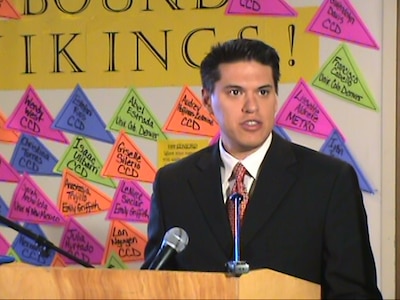More Denver Public Schools students are graduating from high school and going to college, according to figures released Thursday about the Class of 2009.
DPS’ overall graduation rate climbed 3.2 percentage points, to 52.7 percent – the biggest jump in graduation rates since 2003, according to district statistics. In 2008, DPS graduated 2,879 students out of 5,818 who started high school four years before and in 2009, the district graduated 2,893 students out of 5,494.
In addition, the number of spring 2009 graduates enrolling in a college or university this fall increased by 7 percentage points, to 49 percent.
“This is the critical issue for the Denver Public Schools – to be dramatically increasing the number of our students who are graduating high school prepared for college and career,” DPS Superintendent Tom Boasberg said during an afternoon press conference at North High School.
“These are the most significant increases we’ve seen in many years,” Boasberg added. “However, we’ve got much, much work to do.”
North’s graduation rate increased by 12.1 percentage points, to 58.2 percent, making it the district’s top high school in growth. In sheer numbers, that represents an increase in graduates from 142 in spring 2008 to 189 in spring 2009.
Johnny Alvarado, a May 2009 North grad, attended Thursday’s press conference and credited the Denver Scholarship Foundation’s Futures Center at the school with helping him get to Regis University this fall.
The Futures Center assists students and families in learning about colleges, filling out applications and applying for scholarships and other financial aid.
The foundation, seeded with a $50 million gift from Denver oilman Tim Marquez and his wife Bernadette, also provides scholarships to DPS graduates.
“I wasn’t even thinking about going to college when I first came here,” Alvarado said. “But after I found out about the many opportunities I have here, I just took them and ran forward with them.”
But even as Boasberg praised the progress made, he also said the pace of growth needs to accelerate. He termed a 53 percent graduation rate as “not acceptable.”
“I don’t believe modest changes are what we need if we’re going to have dramatically different and dramatically better results,” he said, “and we need to have dramatically better results.”
The district’s goal is to increase its graduation rate by 5 percent each year – this year’s 3.2 percent growth falls short of that goal.
Boasberg said the district’s intense focus on college-readiness has resulted in other gains, including:
- The number of students taking college classes while still enrolled in high school increased by 56 percent this year.
- The number of students taking rigorous Advanced Placement or AP courses increased by 32 percent this year.
- The number of students taking AP courses and passing the final AP exam, which earns them college credit, increased by 23.5 percent this year.
- The percentage of high school juniors scoring a 20 or better on the ACT college-entrance exam increased by 2 points, to 28.2 percent.
Those indicators show the level of rigor in high school is increasing as the high school graduation rate increases, Boasberg said.
That’s important because, in years past, as some Denver high schools have seen their graduation rates increase, they’ve also reported a higher number of graduates requiring remedial classes in college. (See story here.)
For example, Abraham Lincoln High School’s graduation rate increased by 20 percentage points between 2006 and 2008. But the number of Lincoln grads requiring remedial work in college grew by 35 percentage points during those same years, according to state documents.
“It’s something we see as a central challenge – graduating students prepared for college and that means no remediation,” Boasberg said.
Lincoln’s graduation rate dropped slightly this year, down 3 percentage points to 64.9 percent. Montbello and South high schools also saw slight declines in their graduation rates, with each down 1.9 percentage point. South’s graduation rate was 67.4 percent for the Class of 2009 while Montbello’s was 57.4 percent.
West High School had the lowest graduation rate, at 50.9 percent, but that figure represents an increase of 3.6 percentage points over spring 2008.
The Denver School of the Arts had the highest graduation rate, at 97.3 percent, an increase of 2.3 percentage points, followed by the Denver Center for International Studies at 90 percent, a decline of 5.7 percentage points from 2008.
North, with its 12.1 percentage point gain, led all other high schools in growth.

Principal Ed Salem credited initiatives such as the school’s three-year partnership with the Denver Scholarship Foundation and the addition of web-based “credit recovery” classes that allow students to make up failed courses on their lunch hours, after school and on Saturdays.
Next fall, North will begin offering an AP course, human geography, to freshmen in an effort to get them on the path to college. Salem said he wants to enroll all freshmen in the course by fall 2011.
“It’s motivating,” he said of Thursday’s data as he stood in front of a wall covered with colorful banners showing where North students are going to college. “It really validates the work we are all doing here.”
Nancy Mitchell can be reached at nmitchell@pebc.org or 303-478-4573.
Click here to see a breakdown of DPS graduation rates by high school.
Click here to see a report containing historical data, including how graduation rates are calculated on p. 3.
